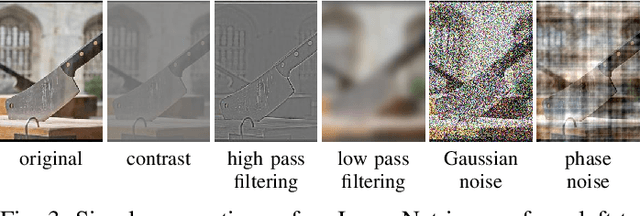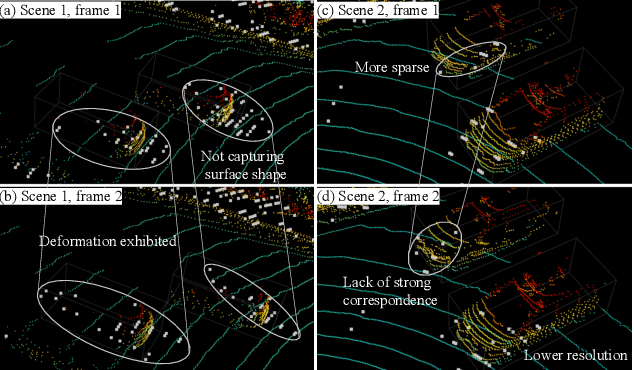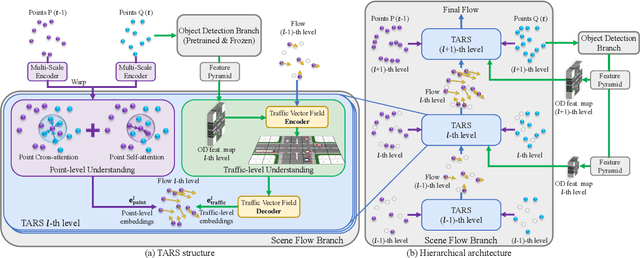Matthias Rottmann
Learning to Detect Label Errors by Making Them: A Method for Segmentation and Object Detection Datasets
Aug 25, 2025Abstract:Recently, detection of label errors and improvement of label quality in datasets for supervised learning tasks has become an increasingly important goal in both research and industry. The consequences of incorrectly annotated data include reduced model performance, biased benchmark results, and lower overall accuracy. Current state-of-the-art label error detection methods often focus on a single computer vision task and, consequently, a specific type of dataset, containing, for example, either bounding boxes or pixel-wise annotations. Furthermore, previous methods are not learning-based. In this work, we overcome this research gap. We present a unified method for detecting label errors in object detection, semantic segmentation, and instance segmentation datasets. In a nutshell, our approach - learning to detect label errors by making them - works as follows: we inject different kinds of label errors into the ground truth. Then, the detection of label errors, across all mentioned primary tasks, is framed as an instance segmentation problem based on a composite input. In our experiments, we compare the label error detection performance of our method with various baselines and state-of-the-art approaches of each task's domain on simulated label errors across multiple tasks, datasets, and base models. This is complemented by a generalization study on real-world label errors. Additionally, we release 459 real label errors identified in the Cityscapes dataset and provide a benchmark for real label error detection in Cityscapes.
LFA applied to CNNs: Efficient Singular Value Decomposition of Convolutional Mappings by Local Fourier Analysis
Jun 05, 2025Abstract:The singular values of convolutional mappings encode interesting spectral properties, which can be used, e.g., to improve generalization and robustness of convolutional neural networks as well as to facilitate model compression. However, the computation of singular values is typically very resource-intensive. The naive approach involves unrolling the convolutional mapping along the input and channel dimensions into a large and sparse two-dimensional matrix, making the exact calculation of all singular values infeasible due to hardware limitations. In particular, this is true for matrices that represent convolutional mappings with large inputs and a high number of channels. Existing efficient methods leverage the Fast Fourier transformation (FFT) to transform convolutional mappings into the frequency domain, enabling the computation of singular values for matrices representing convolutions with larger input and channel dimensions. For a constant number of channels in a given convolution, an FFT can compute N singular values in O(N log N) complexity. In this work, we propose an approach of complexity O(N) based on local Fourier analysis, which additionally exploits the shift invariance of convolutional operators. We provide a theoretical analysis of our algorithm's runtime and validate its efficiency through numerical experiments. Our results demonstrate that our proposed method is scalable and offers a practical solution to calculate the entire set of singular values - along with the corresponding singular vectors if needed - for high-dimensional convolutional mappings.
Temporal Object Captioning for Street Scene Videos from LiDAR Tracks
May 22, 2025Abstract:Video captioning models have seen notable advancements in recent years, especially with regard to their ability to capture temporal information. While many research efforts have focused on architectural advancements, such as temporal attention mechanisms, there remains a notable gap in understanding how models capture and utilize temporal semantics for effective temporal feature extraction, especially in the context of Advanced Driver Assistance Systems. We propose an automated LiDAR-based captioning procedure that focuses on the temporal dynamics of traffic participants. Our approach uses a rule-based system to extract essential details such as lane position and relative motion from object tracks, followed by a template-based caption generation. Our findings show that training SwinBERT, a video captioning model, using only front camera images and supervised with our template-based captions, specifically designed to encapsulate fine-grained temporal behavior, leads to improved temporal understanding consistently across three datasets. In conclusion, our results clearly demonstrate that integrating LiDAR-based caption supervision significantly enhances temporal understanding, effectively addressing and reducing the inherent visual/static biases prevalent in current state-of-the-art model architectures.
LiDAR MOT-DETR: A LiDAR-based Two-Stage Transformer for 3D Multiple Object Tracking
May 19, 2025Abstract:Multi-object tracking from LiDAR point clouds presents unique challenges due to the sparse and irregular nature of the data, compounded by the need for temporal coherence across frames. Traditional tracking systems often rely on hand-crafted features and motion models, which can struggle to maintain consistent object identities in crowded or fast-moving scenes. We present a lidar-based two-staged DETR inspired transformer; a smoother and tracker. The smoother stage refines lidar object detections, from any off-the-shelf detector, across a moving temporal window. The tracker stage uses a DETR-based attention block to maintain tracks across time by associating tracked objects with the refined detections using the point cloud as context. The model is trained on the datasets nuScenes and KITTI in both online and offline (forward peeking) modes demonstrating strong performance across metrics such as ID-switch and multiple object tracking accuracy (MOTA). The numerical results indicate that the online mode outperforms the lidar-only baseline and SOTA models on the nuScenes dataset, with an aMOTA of 0.722 and an aMOTP of 0.475, while the offline mode provides an additional 3 pp aMOTP
On Background Bias of Post-Hoc Concept Embeddings in Computer Vision DNNs
Apr 11, 2025Abstract:The thriving research field of concept-based explainable artificial intelligence (C-XAI) investigates how human-interpretable semantic concepts embed in the latent spaces of deep neural networks (DNNs). Post-hoc approaches therein use a set of examples to specify a concept, and determine its embeddings in DNN latent space using data driven techniques. This proved useful to uncover biases between different target (foreground or concept) classes. However, given that the background is mostly uncontrolled during training, an important question has been left unattended so far: Are/to what extent are state-of-the-art, data-driven post-hoc C-XAI approaches themselves prone to biases with respect to their backgrounds? E.g., wild animals mostly occur against vegetation backgrounds, and they seldom appear on roads. Even simple and robust C-XAI methods might abuse this shortcut for enhanced performance. A dangerous performance degradation of the concept-corner cases of animals on the road could thus remain undiscovered. This work validates and thoroughly confirms that established Net2Vec-based concept segmentation techniques frequently capture background biases, including alarming ones, such as underperformance on road scenes. For the analysis, we compare 3 established techniques from the domain of background randomization on >50 concepts from 2 datasets, and 7 diverse DNN architectures. Our results indicate that even low-cost setups can provide both valuable insight and improved background robustness.
Shape Bias and Robustness Evaluation via Cue Decomposition for Image Classification and Segmentation
Mar 16, 2025



Abstract:Previous works studied how deep neural networks (DNNs) perceive image content in terms of their biases towards different image cues, such as texture and shape. Previous methods to measure shape and texture biases are typically style-transfer-based and limited to DNNs for image classification. In this work, we provide a new evaluation procedure consisting of 1) a cue-decomposition method that comprises two AI-free data pre-processing methods extracting shape and texture cues, respectively, and 2) a novel cue-decomposition shape bias evaluation metric that leverages the cue-decomposition data. For application purposes we introduce a corresponding cue-decomposition robustness metric that allows for the estimation of the robustness of a DNN w.r.t. image corruptions. In our numerical experiments, our findings for biases in image classification DNNs align with those of previous evaluation metrics. However, our cue-decomposition robustness metric shows superior results in terms of estimating the robustness of DNNs. Furthermore, our results for DNNs on the semantic segmentation datasets Cityscapes and ADE20k for the first time shed light into the biases of semantic segmentation DNNs.
Poly-MgNet: Polynomial Building Blocks in Multigrid-Inspired ResNets
Mar 13, 2025Abstract:The structural analogies of ResNets and Multigrid (MG) methods such as common building blocks like convolutions and poolings where already pointed out by He et al.\ in 2016. Multigrid methods are used in the context of scientific computing for solving large sparse linear systems arising from partial differential equations. MG methods particularly rely on two main concepts: smoothing and residual restriction / coarsening. Exploiting these analogies, He and Xu developed the MgNet framework, which integrates MG schemes into the design of ResNets. In this work, we introduce a novel neural network building block inspired by polynomial smoothers from MG theory. Our polynomial block from an MG perspective naturally extends the MgNet framework to Poly-Mgnet and at the same time reduces the number of weights in MgNet. We present a comprehensive study of our polynomial block, analyzing the choice of initial coefficients, the polynomial degree, the placement of activation functions, as well as of batch normalizations. Our results demonstrate that constructing (quadratic) polynomial building blocks based on real and imaginary polynomial roots enhances Poly-MgNet's capacity in terms of accuracy. Furthermore, our approach achieves an improved trade-off of model accuracy and number of weights compared to ResNet as well as compared to specific configurations of MgNet.
TARS: Traffic-Aware Radar Scene Flow Estimation
Mar 13, 2025



Abstract:Scene flow provides crucial motion information for autonomous driving. Recent LiDAR scene flow models utilize the rigid-motion assumption at the instance level, assuming objects are rigid bodies. However, these instance-level methods are not suitable for sparse radar point clouds. In this work, we present a novel $\textbf{T}$raffic-$\textbf{A}$ware $\textbf{R}$adar $\textbf{S}$cene flow estimation method, named $\textbf{TARS}$, which utilizes the motion rigidity at the traffic level. To address the challenges in radar scene flow, we perform object detection and scene flow jointly and boost the latter. We incorporate the feature map from the object detector, trained with detection losses, to make radar scene flow aware of the environment and road users. Therefrom, we construct a Traffic Vector Field (TVF) in the feature space, enabling a holistic traffic-level scene understanding in our scene flow branch. When estimating the scene flow, we consider both point-level motion cues from point neighbors and traffic-level consistency of rigid motion within the space. TARS outperforms the state of the art on a proprietary dataset and the View-of-Delft dataset, improving the benchmarks by 23% and 15%, respectively.
Does Knowledge About Perceptual Uncertainty Help an Agent in Automated Driving?
Feb 17, 2025Abstract:Agents in real-world scenarios like automated driving deal with uncertainty in their environment, in particular due to perceptual uncertainty. Although, reinforcement learning is dedicated to autonomous decision-making under uncertainty these algorithms are typically not informed about the uncertainty currently contained in their environment. On the other hand, uncertainty estimation for perception itself is typically directly evaluated in the perception domain, e.g., in terms of false positive detection rates or calibration errors based on camera images. Its use for deciding on goal-oriented actions remains largely unstudied. In this paper, we investigate how an agent's behavior is influenced by an uncertain perception and how this behavior changes if information about this uncertainty is available. Therefore, we consider a proxy task, where the agent is rewarded for driving a route as fast as possible without colliding with other road users. For controlled experiments, we introduce uncertainty in the observation space by perturbing the perception of the given agent while informing the latter. Our experiments show that an unreliable observation space modeled by a perturbed perception leads to a defensive driving behavior of the agent. Furthermore, when adding the information about the current uncertainty directly to the observation space, the agent adapts to the specific situation and in general accomplishes its task faster while, at the same time, accounting for risks.
Benchmarking Vision Foundation Models for Input Monitoring in Autonomous Driving
Jan 14, 2025Abstract:Deep neural networks (DNNs) remain challenged by distribution shifts in complex open-world domains like automated driving (AD): Absolute robustness against yet unknown novel objects (semantic shift) or styles like lighting conditions (covariate shift) cannot be guaranteed. Hence, reliable operation-time monitors for identification of out-of-training-data-distribution (OOD) scenarios are imperative. Current approaches for OOD classification are untested for complex domains like AD, are limited in the kinds of shifts they detect, or even require supervision with OOD samples. To prepare for unanticipated shifts, we instead establish a framework around a principled, unsupervised, and model-agnostic method that unifies detection of all kinds of shifts: Find a full model of the training data's feature distribution, to then use its density at new points as in-distribution (ID) score. To implement this, we propose to combine the newly available Vision Foundation Models (VFM) as feature extractors with one of four alternative density modeling techniques. In an extensive benchmark of 4 VFMs against 20 baselines, we show the superior performance of VFM feature encodings compared to shift-specific OOD monitors. Additionally, we find that sophisticated architectures outperform larger latent space dimensionality; and our method identifies samples with higher risk of errors on downstream tasks, despite being model-agnostic. This suggests that VFMs are promising to realize model-agnostic, unsupervised, reliable safety monitors in complex vision tasks.
 Add to Chrome
Add to Chrome Add to Firefox
Add to Firefox Add to Edge
Add to Edge